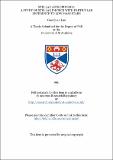Files in this item
Stellar astrophysics: a study of stellar physics with particular reference to low mass stars
Item metadata
| dc.contributor.advisor | Carson, T. R. (Thomas Richard) | |
| dc.contributor.author | Luo, Guo Quan | |
| dc.coverage.spatial | 150 p. | en_US |
| dc.date.accessioned | 2018-06-20T11:00:11Z | |
| dc.date.available | 2018-06-20T11:00:11Z | |
| dc.date.issued | 1991 | |
| dc.identifier.uri | https://hdl.handle.net/10023/14326 | |
| dc.description.abstract | In this thesis we investigate the importance of various elements of the input physics and other parameters which affect the structure and evolution of models of low mass stars. Of the elements of input physics, the nuclear generation rates, the electron screening effect on thermo-nuclear reactions, and the conductive opacities are adopted from the formulation or data tables by other contributors. The low temperature opacities are taken from the data calculated by Carson and Sharp, as well as those by Alexander. In our study, we establish a sophisticated model for the determination of the equation of state. It is formulated by a new method based on the theory of the grand canonical ensemble. The interatomic interactions, which are responsible for the nonideal effects and pressure ionization, are treated carefully in the equation of state. In addition, and consistent with the equation of state, we also evaluate the radiative opacity according to the average atom model for heavy elements and the hydrogen-like model for hydrogen and helium. Negative hydrogen absorption and free electron scattering are also included. A computing code is constructed to calculate the radiative opacity data which are required in the study of low mass stars. To investigate the importance of each element of the input physics, we exclude it or replace it with an alternative for the model calculations. The parameters of the stellar code, such as the element abundances, the surface condition and the mixing length ratio are as well investigated by alternative values or formulation. In the computation, all elements of input physics, except the energy generation rates, are incorporated into the main code by means of data tables. A bicubic interpolation is used for their input. Our numerical calculations cover the zero age main sequence of the stars ranging from a solar mass down to the hydrogen burning minimum mass. The calculated results of the zero age models for the Standard Population I and Population II indicate good agreement with the observed data for the objects with effective temperatures above 3000 K, or with masses greater than 0,15 M[sub]sun. Below this limit, in agreement with other theoretical work, there is still a small discrepancy between the theoretical models and the observed data. The investigations of the effects of the input physics and model parameters show that some of them affect considerably the minimum mass limit for hydrogen burning on the lower main sequence. The low temperature opacities, the nonideal effects in the EOS and the conductive opacities lead to a limiting mass ranging from 0.08 M[sub]sun to 0.15 M[sub]sun although they do not affect the models with masses above 0.15 M[sub]sun obviously. The investigations also show that the massive models of the lower main sequence (i.e. those with mass near the sun) are dependent very much on the element abundances and the mixing length ratio while the lower mass models are not. The lower main sequence models are found to be insensitive to the surface condition (photospheric model or atmospheric model) used. We also perform the calculation of the evolutionary models of the lower main sequence from the zero age up to an age of 10¹⁰ years. A perfect theoretical model of the solar evolution is obtained when the atmospheric model is used as surface condition, the element abundances are chosen to be 0.70/0.28/0.02 and the mixing length ratio to be 1.5. The investigations show that the element abundances are the most important parameters in the determination of the solar models. The mixing length ratio is the second most important one being much more important than the physical model used as surface condition. The evolutionary models of the masses below 0.8 M[sub]sun are found to have only small changes in their properties within 10¹⁰ years. None of them can deplete their central hydrogen in that time. We find one problem in that the models with masses around 0.1 M[sub]sun have oscillating solutions for both the zero age models and evolutionary models. According to our investigation, the nonideal effects in the EOS can be responsible. These oscillating solutions imply the existence of more than one stable configuration for stellar masses. | en_US |
| dc.language.iso | en | en_US |
| dc.publisher | University of St Andrews | |
| dc.subject.lcc | QB807.L9 | |
| dc.subject.lcsh | Astrometry | en |
| dc.title | Stellar astrophysics: a study of stellar physics with particular reference to low mass stars | en_US |
| dc.type | Thesis | en_US |
| dc.contributor.sponsor | British Council | en_US |
| dc.contributor.sponsor | China. (Government) | en_US |
| dc.type.qualificationlevel | Doctoral | en_US |
| dc.type.qualificationname | PhD Doctor of Philosophy | en_US |
| dc.publisher.institution | The University of St Andrews | en_US |
This item appears in the following Collection(s)
Items in the St Andrews Research Repository are protected by copyright, with all rights reserved, unless otherwise indicated.

